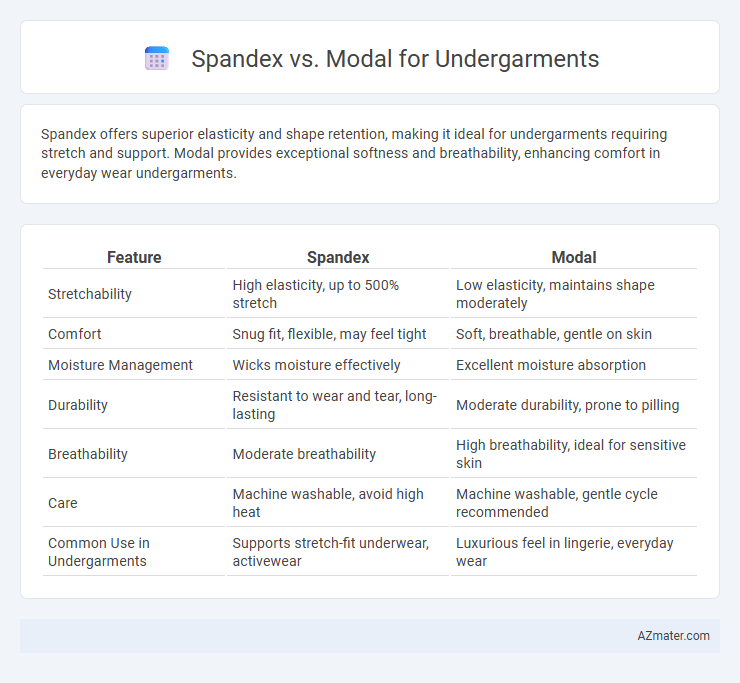Spandex offers superior elasticity and shape retention, making it ideal for undergarments requiring stretch and support. Modal provides exceptional softness and breathability, enhancing comfort in everyday wear undergarments.
Table of Comparison
| Feature | Spandex | Modal |
|---|---|---|
| Stretchability | High elasticity, up to 500% stretch | Low elasticity, maintains shape moderately |
| Comfort | Snug fit, flexible, may feel tight | Soft, breathable, gentle on skin |
| Moisture Management | Wicks moisture effectively | Excellent moisture absorption |
| Durability | Resistant to wear and tear, long-lasting | Moderate durability, prone to pilling |
| Breathability | Moderate breathability | High breathability, ideal for sensitive skin |
| Care | Machine washable, avoid high heat | Machine washable, gentle cycle recommended |
| Common Use in Undergarments | Supports stretch-fit underwear, activewear | Luxurious feel in lingerie, everyday wear |
Introduction to Spandex and Modal Fabrics
Spandex, known for its exceptional elasticity, is a synthetic fiber made from polyurethane that offers superior stretch and recovery, making it ideal for form-fitting undergarments. Modal, a type of semi-synthetic rayon derived from beech tree pulp, is prized for its softness, breathability, and moisture-wicking properties, enhancing comfort in intimate wear. Both fabrics provide unique benefits, with spandex delivering flexibility and durability, while modal ensures a smooth, silky feel and temperature regulation.
What is Spandex? Key Features and Benefits
Spandex is a synthetic fiber known for its exceptional elasticity, often used in undergarments to provide a snug fit and enhanced comfort. Key features include high stretchability, shape retention, and resistance to sweat and body oils, making it ideal for activewear and everyday use. Benefits of spandex undergarments include improved freedom of movement, durable fit, and moisture-wicking properties that maintain dryness and reduce irritation.
What is Modal? Key Features and Benefits
Modal is a semi-synthetic fiber derived from beech tree pulp, known for its exceptional softness and breathability, making it ideal for undergarments. Key features include high moisture-wicking capability, resistance to shrinkage, and exceptional color retention after multiple washes. Benefits of modal fabric in undergarments are enhanced comfort, durability, and a smooth feel against the skin, promoting all-day freshness and flexibility.
Breathability and Comfort: Spandex vs Modal
Modal fabric offers superior breathability and moisture-wicking properties, making it ideal for comfortable undergarments that keep skin dry and cool. Spandex provides excellent stretch and shape retention but lacks the breathability found in natural fibers like Modal. Combining Modal's softness with Spandex's elasticity often results in undergarments that balance comfort and fit effectively.
Moisture-Wicking and Sweat Control
Spandex offers exceptional stretch and support but has limited moisture-wicking capabilities, making it less effective in sweat control for undergarments. Modal fibers excel in moisture absorption and breathability, enhancing comfort by efficiently wicking sweat away from the skin. Combining Modal with Spandex in undergarments optimizes both moisture management and flexibility, ideal for activewear.
Durability and Longevity Comparison
Spandex provides exceptional elasticity and resilience, making undergarments highly durable and resistant to shape loss over time, which enhances their longevity. Modal fibers offer a soft, breathable feel but tend to be less stretchable and may show wear sooner with frequent washing and use. When comparing durability and longevity, spandex blends outperform modal by maintaining fit and structural integrity through prolonged wear and multiple wash cycles.
Stretch and Flexibility for Undergarments
Spandex offers superior stretch and elasticity, making it ideal for undergarments that require maximum flexibility and shape retention throughout the day. Modal, while soft and breathable, provides less stretch and is best suited for comfort-focused undergarments that prioritize moisture-wicking and a smooth feel against the skin. Blending modal with spandex enhances flexibility while maintaining softness, creating undergarments that balance stretch with comfort effectively.
Hypoallergenic and Skin Sensitivity Factors
Modal fabric is highly recommended for undergarments due to its natural fibers and excellent breathability, making it hypoallergenic and gentle on sensitive skin. Spandex, while offering superior stretch and shape retention, may cause irritation for individuals with extremely sensitive skin or allergies to synthetic materials. For hypoallergenic comfort, modal blends often provide a balance of softness and durability without compromising skin health.
Sustainability and Environmental Impact
Modal fabric, derived from sustainable beech tree pulp and produced through a closed-loop process, offers a lower environmental footprint compared to Spandex, which is a synthetic fiber made from non-renewable petroleum-based materials. The biodegradability of Modal and its lower water and energy consumption during production contribute to its eco-friendliness, whereas Spandex involves higher energy use, chemical treatments, and limited biodegradability, raising concerns about microplastic pollution. For undergarments prioritizing sustainability, Modal provides a more environmentally responsible choice while maintaining softness and breathability, unlike Spandex which primarily adds stretch but at higher environmental costs.
Which Fabric is Best for Undergarments?
Spandex offers exceptional elasticity and shape retention, making it ideal for form-fitting undergarments that require flexibility and support. Modal, a type of rayon made from beech tree pulp, excels in breathability, softness, and moisture-wicking properties, providing superior comfort for sensitive skin. For optimal undergarment performance, a blend of spandex and modal combines durability and stretch with natural softness and moisture management.

Infographic: Spandex vs Modal for Undergarment
 azmater.com
azmater.com